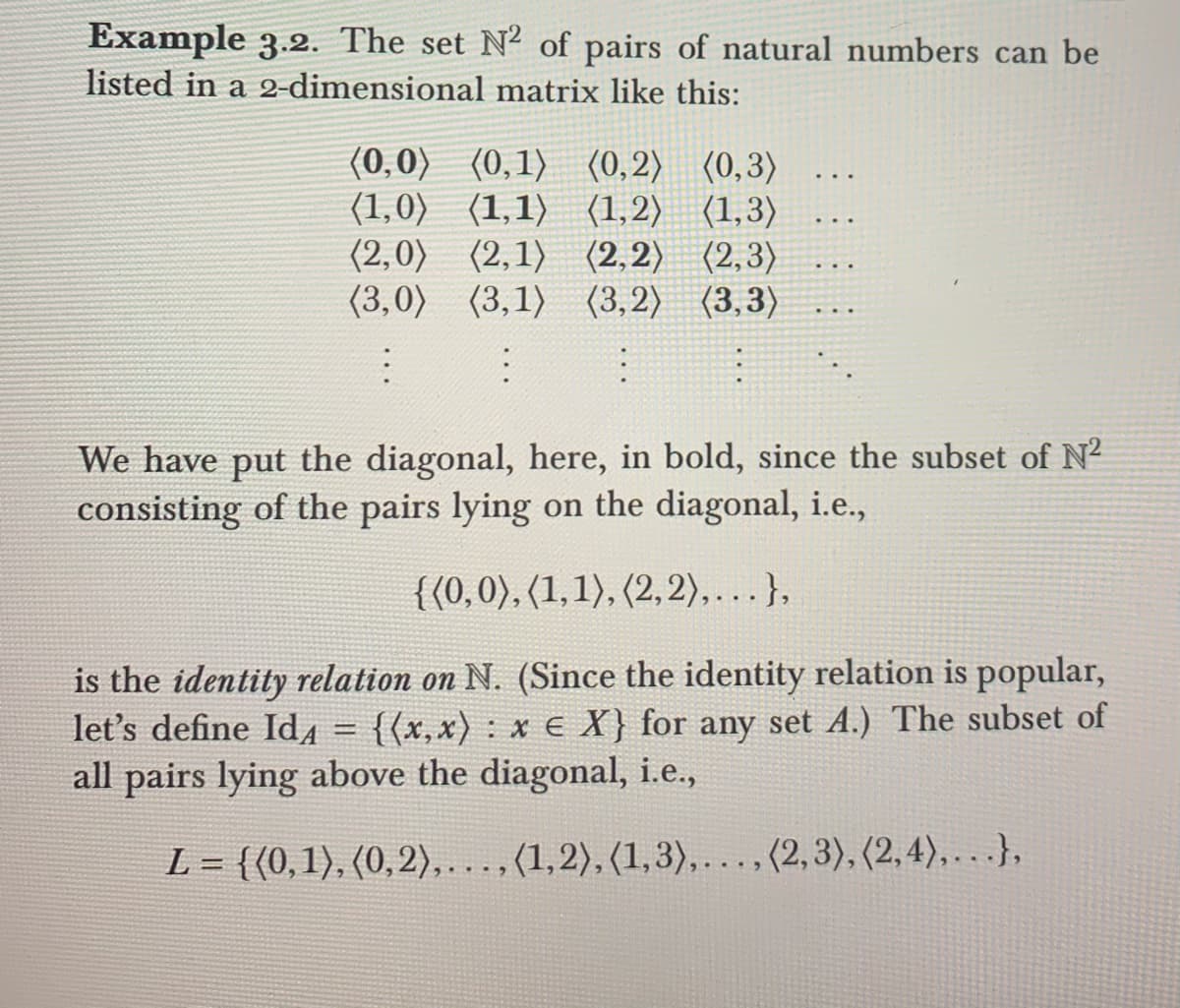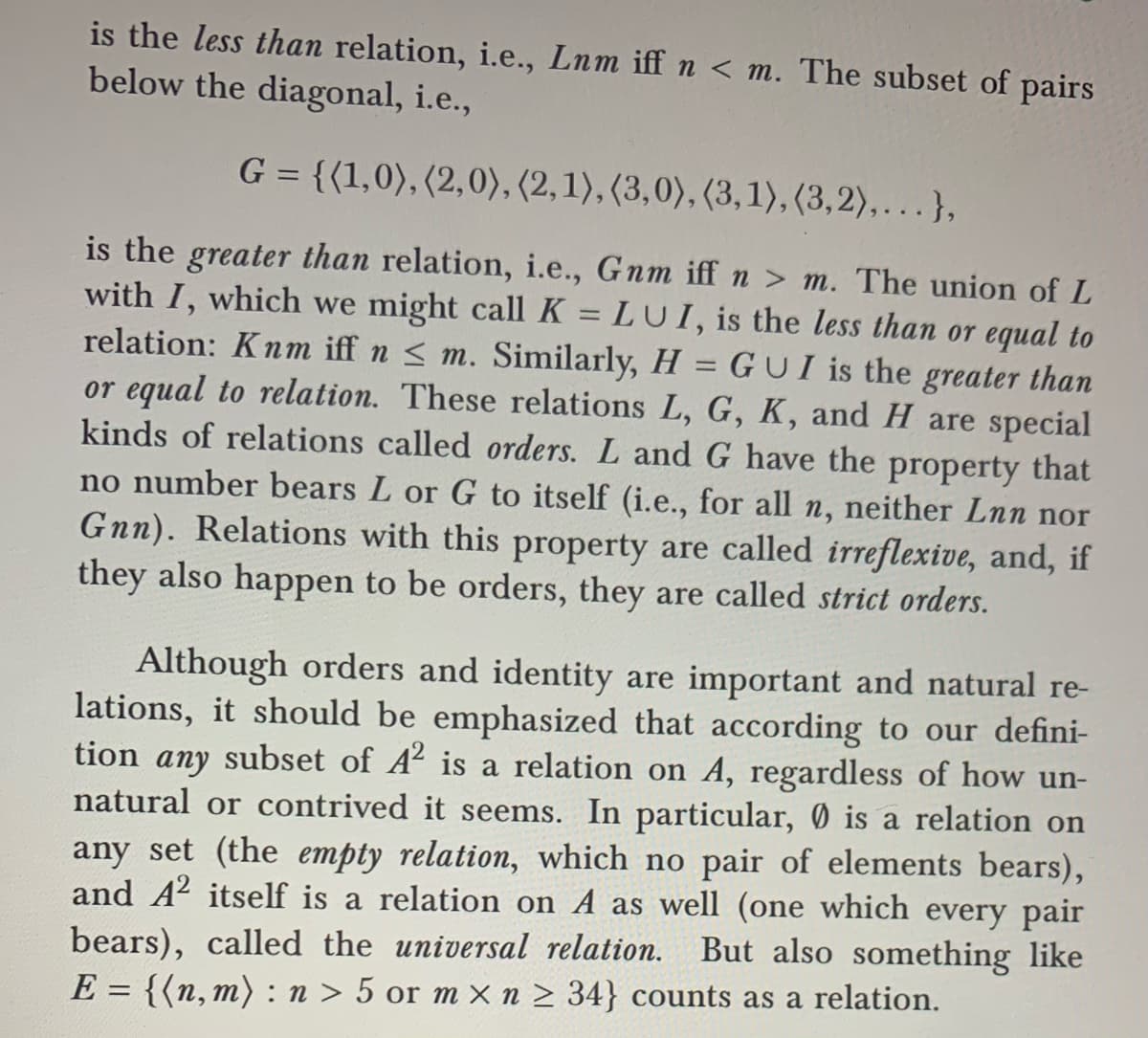There are 3 parts to this question. The answer choices for each are all. 1) reflexive 2) irreflexive 3) symmetric 4) anti-symmetric 5) asymmetric 6) transitive 7) connected Part A) consider the relation L in example 3.2. Choose all the properties L has. Part B) let I be the identity relation on N in example 3.2. Choose all properties which I has.
There are 3 parts to this question. The answer choices for each are all. 1) reflexive 2) irreflexive 3) symmetric 4) anti-symmetric 5) asymmetric 6) transitive 7) connected Part A) consider the relation L in example 3.2. Choose all the properties L has. Part B) let I be the identity relation on N in example 3.2. Choose all properties which I has.
Elementary Linear Algebra (MindTap Course List)
8th Edition
ISBN:9781305658004
Author:Ron Larson
Publisher:Ron Larson
Chapter5: Inner Product Spaces
Section5.CM: Cumulative Review
Problem 8CM: Take this test to review the material in Chapters 4 and 5. After you are finished, check your work...
Related questions
Question
There are 3 parts to this question. The answer choices for each are all.
1) reflexive
2) irreflexive
3) symmetric
4) anti-symmetric
5) asymmetric
6) transitive
7) connected
Part A) consider the relation L in example 3.2. Choose all the properties L has.
Part B) let I be the identity relation on N in example 3.2. Choose all properties which I has.
Part C) consider the relation K in example 3.2 defined by K=LUI where I is the identity relation. Choose all properties K has.

Transcribed Image Text:Example 3.2. The set N² of pairs of natural numbers can be
listed in a 2-dimensional matrix like this:
(0,0) (0,1) (0,2) (0,3)
(1,0) (1,1) (1,2) (1,3)
(2,0)
(3,0) (3,1) (3,2) (3,3)
(2,1) (2,2) (2,3)
...
...
We have put the diagonal, here, in bold, since the subset of N2
consisting of the pairs lying on the diagonal, i.e.,
{{0,0), (1,1), (2, 2),...},
is the identity relation on N. (Since the identity relation is popular,
let's define Id,
{{x,x) : x € X} for any set A.) The subset of
all pairs lying above the diagonal, i.e.,
L = {(0,1), (0,2),..., (1,2), (1,3),..., (2, 3), (2,4), .},

Transcribed Image Text:is the less than relation, i.e., Lnm iff n < m. The subset of pairs
below the diagonal, i.e.,
G = {(1,0), (2,0), (2, 1), (3,0), (3,1), (3,2),.},
is the greater than relation, i.e., Gnm iffn > m. The union of L
with I, which we might call K = LUI, is the less than or equal to
relation: Knm iff n < m. Similarly, H = G U I is the greater than
or equal to relation. These relations L, G, K, and H are special
kinds of relations called orders. L and G have the property that
no number bears L or G to itself (i.e., for all n, neither Lnn nor
Gnn). Relations with this property are called irreflexive, and, if
they also happen to be orders, they are called strict orders.
Although orders and identity are important and natural re-
lations, it should be emphasized that according to our defini-
tion any subset of A² is a relation on A, regardless of how un-
natural or contrived it seems. In particular, 0 is a relation on
any set (the empty relation, which no pair of elements bears),
and A2 itself is a relation on A as well (one which every pair
bears), called the universal relation. But also something like
E = {(n, m) : n > 5 or m x n > 34} counts as a relation.
Expert Solution
This question has been solved!
Explore an expertly crafted, step-by-step solution for a thorough understanding of key concepts.
This is a popular solution!
Trending now
This is a popular solution!
Step by step
Solved in 2 steps with 2 images

Knowledge Booster
Learn more about
Need a deep-dive on the concept behind this application? Look no further. Learn more about this topic, advanced-math and related others by exploring similar questions and additional content below.Recommended textbooks for you

Elementary Linear Algebra (MindTap Course List)
Algebra
ISBN:
9781305658004
Author:
Ron Larson
Publisher:
Cengage Learning

Linear Algebra: A Modern Introduction
Algebra
ISBN:
9781285463247
Author:
David Poole
Publisher:
Cengage Learning

Elements Of Modern Algebra
Algebra
ISBN:
9781285463230
Author:
Gilbert, Linda, Jimmie
Publisher:
Cengage Learning,

Elementary Linear Algebra (MindTap Course List)
Algebra
ISBN:
9781305658004
Author:
Ron Larson
Publisher:
Cengage Learning

Linear Algebra: A Modern Introduction
Algebra
ISBN:
9781285463247
Author:
David Poole
Publisher:
Cengage Learning

Elements Of Modern Algebra
Algebra
ISBN:
9781285463230
Author:
Gilbert, Linda, Jimmie
Publisher:
Cengage Learning,


Algebra for College Students
Algebra
ISBN:
9781285195780
Author:
Jerome E. Kaufmann, Karen L. Schwitters
Publisher:
Cengage Learning

Algebra & Trigonometry with Analytic Geometry
Algebra
ISBN:
9781133382119
Author:
Swokowski
Publisher:
Cengage